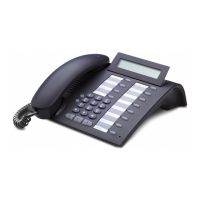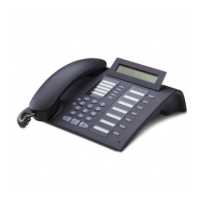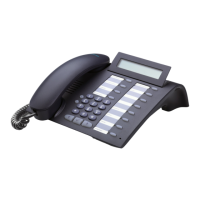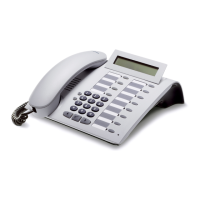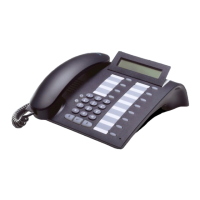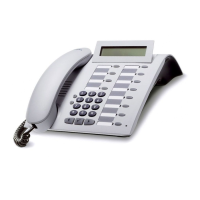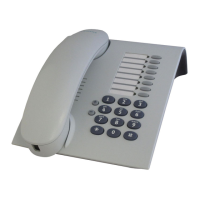



Do you have a question about the Siemens optiPoint 410 economy plus and is the answer not in the manual?
Key information and guidelines for using the telephone.
Explanation of safety marks, environmental considerations, and product compliance.
Description of the telephone's control panel, keys, display, and components.
Explanation of symbols and conventions used in the operating instructions.
Methods for accessing and executing telephone functions via interactive, menu, or key options.
Overview of available basic, enhanced, team, and executive/secretary functions.
Tips for optimizing telephone usage, including saving numbers and using callback.
Guidelines for protecting the IP environment from external attacks and call monitoring.
Instructions for answering incoming calls using handset or speakerphone modes.
Procedures for switching between handset and speakerphone modes during a call.
Enabling others in the room to join a call by using the speakerphone feature.
Basic methods for initiating calls using off-hook and on-hook dialing.
How to redial previously dialed numbers using the redial key.
Controlling the microphone during a call for privacy or announcements.
How to place a call on hold to consult with a second party.
Procedure for transferring an ongoing call to another colleague.
Configuring call forwarding to different destinations based on various conditions.
Accepting calls for colleagues and rejecting unwanted incoming calls.
Instructions for using the speakerphone for calls and enabling/disabling handsfree answerback.
How to answer calls when using a telephone headset.
Using the telephone to speak to visitors and activate door openers.
Entering and correcting numbers before dialing, allowing for error correction.
Retrieving and managing a list of incoming calls and their details.
Storing and using speed-dial numbers for quick access to frequently called numbers.
Searching and dialing numbers from the internal directory and LDAP telephone database.
Accessing and managing voice messages or text messages.
Making speaker calls, discreet calls, and using automatic connection setup.
Configuring the phone to automatically connect to a preset number.
Placing calls on hold and retrieving them later from any phone.
Putting external calls on hold and retrieving them.
Setting up and managing conference calls with multiple participants.
Instructions for recording telephone calls, if the feature is configured.
Activating ISDN services and features by sending a signal to trunks.
Programming frequently used functions or numbers onto programmable keys.
Setting up timed reminders for appointments or calls.
Receiving and responding to timed reminders set for appointments.
Viewing call charge information for current and past calls.
Assigning external calls to specific projects using account codes.
Activating or deactivating the ringer to avoid receiving calls.
Activating or deactivating the Do Not Disturb function to block calls.
Preventing your station number or name from appearing on external displays.
Using the telephone to listen into a room after activating the monitoring function.
Preventing unauthorized use of the telephone by locking it with a PIN.
Setting and managing a personal identification number (PIN) for telephone security.
Sending short text messages to other users or groups.
Viewing and managing messages that have been sent.
Leaving screen messages for internal callers when you are away.
Showing the number of external waiting calls and overload indications.
Using another telephone temporarily or for extended periods as if it were your own.
Indicating receipt of faxes or messages from an answering machine.
Performing a system-wide cancellation of activated telephone functions.
Turning functions on/off for other telephones using associated service codes.
Accessing system functions remotely, like an internal user.
Setting ISDN functions using code dialing in specific countries.
Controlling connected computers or programs via the telephone.
Interacting with PC applications via a Computer Supported Telecommunications Applications interface.
Turning relays on/off to control external facilities like door openers.
Receiving signals from sensors that trigger phone alerts.
Contacting people via their pocket receivers using paging equipment.
Procedures for paging and answering pages with simple paging equipment.
Procedures for paging and answering pages with enhanced paging equipment.
Activating or deactivating audible signals for hunt groups or group calls.
Answering calls intended for other team members from your own telephone.
Configuring audible signaling for calls to multiple internal telephones.
Managing call distribution and agent availability in a group.
Understanding trunk key functions and LED indications for managing calls on trunks.
Answering incoming calls using trunk keys.
Initiating outgoing calls using available trunk keys.
Using trunk keys to place calls on hold and retrieve them.
Managing multiple calls across different trunks.
Immediately forwarding calls on lines to different internal or external destinations.
Using Direct Station Selection keys to reach team members directly.
Performing diagnostic tests on the telephone's functions and LEDs.
Verifying the functions assigned to specific keys on the telephone.
Exiting or joining hunt groups and group calls within a LAN environment.
Activating or deactivating call forwarding for your phone from other system phones.
Configuring telephones as night answer points for incoming calls.
Managing audible call signaling for multiple internal telephones.
Turning relays on/off to control external facilities like door openers.
Activating door openers remotely via the telephone system.
Guide to entering text and characters using the telephone keypad.
Accessing call forwarding settings via the Destinations menu.
Configuring Do Not Disturb status via the Feature Settings menu.
Accessing speed-dial settings via the Use Speed Dialing menu.
Changing the personal identification number (PIN) via the PIN/COS menu.
Accessing DTMF dialing functions via the More features menu.
Viewing call logs via the Caller list display option.
Options for labeling telephone keys by hand or with a computer.
Information on accessing operating instructions online or via CD-ROM.
Overview of optional accessories for customizing the telephone.
Guidelines for cleaning and maintaining the telephone unit.
Solutions for common problems like unresponsive keys or no ringing.
Interpreting and resolving common error messages displayed on the screen.
Information on whom to contact for persistent or unresolved telephone issues.
